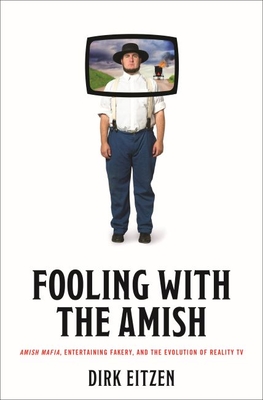Fooling with the Amish: Amish Mafia, Entertaining Fakery, and the Evolution of Reality TV

Fooling with the Amish: Amish Mafia, Entertaining Fakery, and the Evolution of Reality TV
Using Amish Mafia as a window into the interplay between the real and the imagined, this book dissects the peculiar appeals and potential dangers of deception in reality TV and popular entertainment.
When Amish Mafia was released in 2012, viewers were fascinated by the stories of this secret group of Amish and Mennonite enforcers who used threats, extortion, and violence to keep members of the Amish community in line--and to line their own pockets. While some of the stories were based loosely on actual events, the group itself was a complete fabrication. Its members were played by ex-Amish and ex-Mennonite young adults acting out scenarios concocted by the show's producers. What is most extraordinary about Amish Mafia is that, even though it was fictional, it was cleverly constructed to appear real. Discovery Channel, which aired it, assiduously maintained that it was real; whole episodes were devoted to proving that it was real; and many viewers (including smart reality TV fans) were fooled into believing it was real.
In Fooling with the Amish, Dirk Eitzen examines the fakery in Amish Mafia and how actual viewers of the show responded to it to discover answers to two questions that have long puzzled media scholars: What is it about the so-called reality of reality shows that appeals to and gratifies viewers? How and why are people taken in by falsehoods in the media? Eitzen's ultimate answer to these questions is that, in taking liberties with facts, Amish Mafia works very much like gossip. This helps to explain the workings not just of this and other reality TV shows but also of other forms of media fakery, including fake news.
The book winds through numerous fascinating case studies of media fakery, from P. T. Barnum's famous humbugs of the nineteenth century to recent TV news scandals. It examines the social and emotional appeals of other forms of entertaining fakery, including professional wrestling and supermarket tabloids. It explains how and why conventions of contrivance evolved in reality TV as well as the ethics of media fakery. And, for readers interested in the Amish, it tells how the ex-Amish stars of Amish Mafia got involved in the show and the impact that involvement had on their lives.
PRP: 441.26 Lei
Acesta este Pretul Recomandat de Producator. Pretul de vanzare al produsului este afisat mai jos.
397.13Lei
397.13Lei
441.26 LeiLivrare in 2-4 saptamani
Descrierea produsului
Using Amish Mafia as a window into the interplay between the real and the imagined, this book dissects the peculiar appeals and potential dangers of deception in reality TV and popular entertainment.
When Amish Mafia was released in 2012, viewers were fascinated by the stories of this secret group of Amish and Mennonite enforcers who used threats, extortion, and violence to keep members of the Amish community in line--and to line their own pockets. While some of the stories were based loosely on actual events, the group itself was a complete fabrication. Its members were played by ex-Amish and ex-Mennonite young adults acting out scenarios concocted by the show's producers. What is most extraordinary about Amish Mafia is that, even though it was fictional, it was cleverly constructed to appear real. Discovery Channel, which aired it, assiduously maintained that it was real; whole episodes were devoted to proving that it was real; and many viewers (including smart reality TV fans) were fooled into believing it was real.
In Fooling with the Amish, Dirk Eitzen examines the fakery in Amish Mafia and how actual viewers of the show responded to it to discover answers to two questions that have long puzzled media scholars: What is it about the so-called reality of reality shows that appeals to and gratifies viewers? How and why are people taken in by falsehoods in the media? Eitzen's ultimate answer to these questions is that, in taking liberties with facts, Amish Mafia works very much like gossip. This helps to explain the workings not just of this and other reality TV shows but also of other forms of media fakery, including fake news.
The book winds through numerous fascinating case studies of media fakery, from P. T. Barnum's famous humbugs of the nineteenth century to recent TV news scandals. It examines the social and emotional appeals of other forms of entertaining fakery, including professional wrestling and supermarket tabloids. It explains how and why conventions of contrivance evolved in reality TV as well as the ethics of media fakery. And, for readers interested in the Amish, it tells how the ex-Amish stars of Amish Mafia got involved in the show and the impact that involvement had on their lives.
Detaliile produsului








